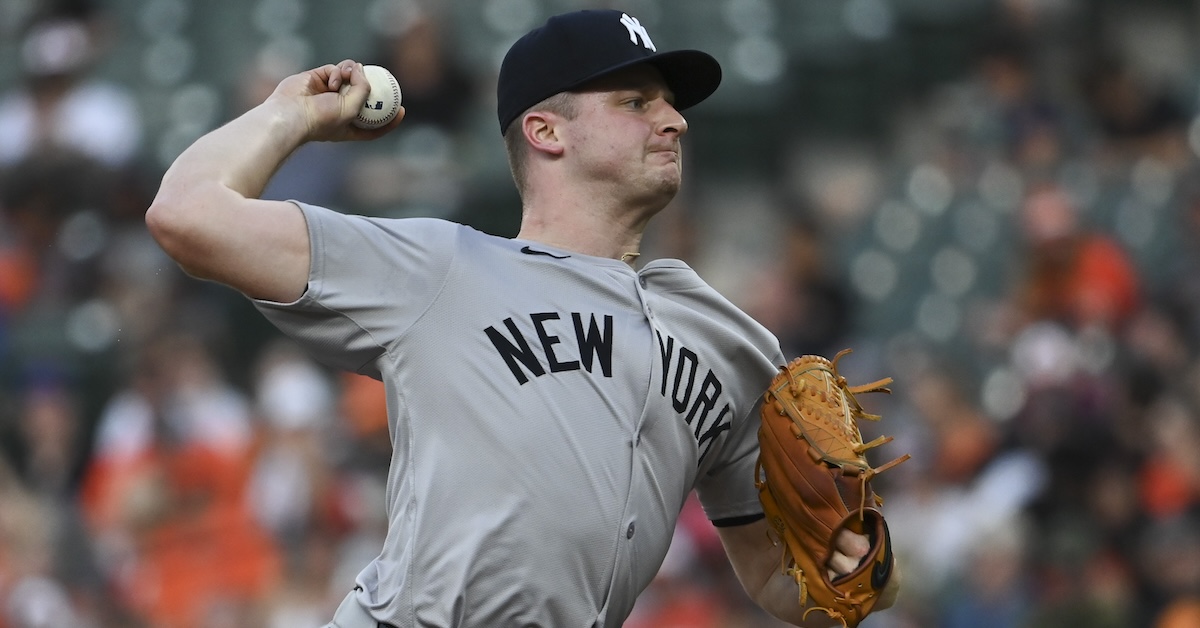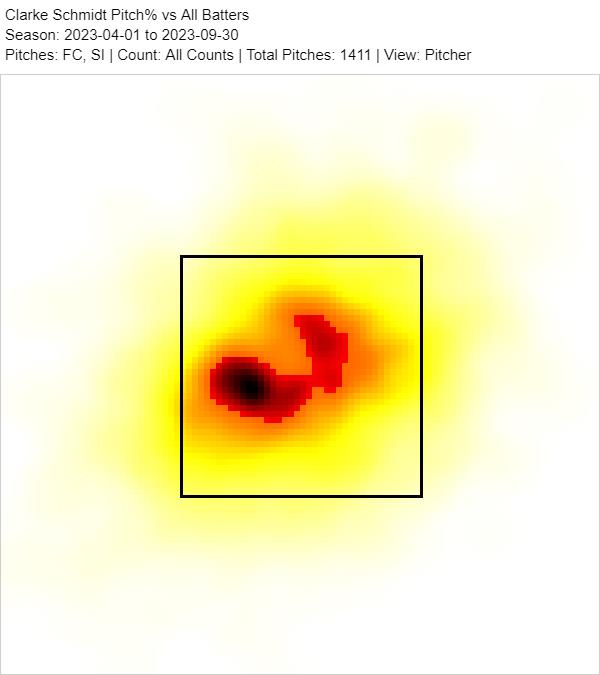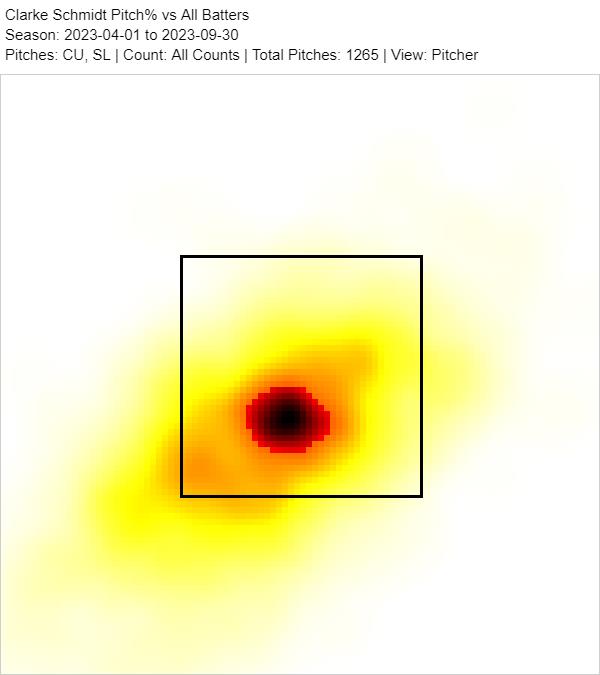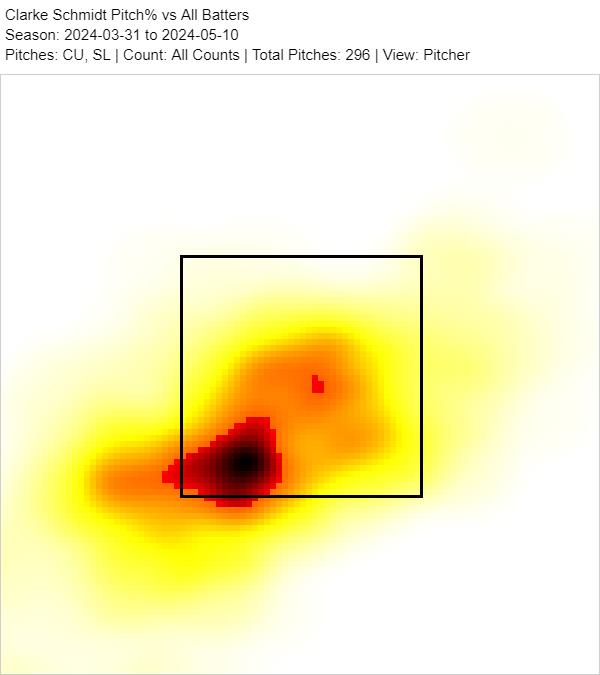
Tommy Gilligan-USA TODAY Sports
Clarke Schmidt has a thing for spin. This season, there are only 14 breaking pitches in the entire league that average 3,000 rpm or more; Schmidt throws two of them. To find another South Carolina alum with such mastery of spin, you’d have to go all the way back to Andrew Card, who was George W. Bush’s chief of staff during the lead-up to the Iraq War. Schmidt’s breaking balls would fit perfectly in a turn-of-the-century alt-rock milieu, alongside the Spin Doctors, or Lifehouse’s “Spin,” or the Goo Goo Dolls’ Dizzy Up the Girl.
Baseball Savant recently started publishing bat tracking data, and the public sabermetric community is currently working out what this new avalanche of data actually means. So it was in the early days of spin rate: How much is too much, and how little is not enough, and how does it vary pitch by pitch? It took a minute to actually sort this stuff out, and as ever, the characteristics of a pitch don’t matter very much if it’s poorly located.
For example: Last year, Schmidt spent his first full season in the Yankees’ big league rotation. And he was fine. His ERA was 4.64, his FIP 4.42. Even though he achieved that vanishingly difficult feat of starting 32 games and throwing 159 innings, he was only a 1.8 WAR pitcher on the season. Opponents hit .265 against him, and his two outrageous breaking pitches landed him smack dab in the 50th percentile for breaking ball run value.
Schmidt’s taken a distinct step forward this season, lowering his ERA to 2.95 in eight starts. While a 14-point uptick in his strand rate likely explains a big chunk of that improvement, Schmidt has made a curious but noticeable advancement a bit further up the causal chain. His strikeout rate, 27.0%, is the highest of his career by some distance. And despite the fact that Schmidt is throwing within the zone less and getting fewer swings overall, his in-zone whiff rate has leaped from 12.8% to 22.1%, which is the third-biggest jump in the league.
Schmidt’s command hasn’t taken a leap forward or anything, nor has he changed his position on the rubber since last year. And his pitch characteristics remain fairly stable. The two breakers are both high-spin pitches, as I’ve said, with severe glove-side movement aided by Clarke’s low three-quarters arm angle. Here he is striking out Curtis Mead on a knuckle-curve that starts away and only gets farther away as it travels:
This pitch looks like it was designed by the chaperone at a parochial school dance — it leaves room for the entire Trinity — and the sweeper is much the same.
In the strike zone, Schmidt has changed his pitch composition this season. He’s going to his cutter more, taking from his sinker and two breaking balls in more or less even proportions. And he’s gotten more whiffs on all four of his pitches within the strike zone:
Clarke Schmidt, In the Zone
| 2023 |
| Cutter |
30.4 |
72.4 |
16.4 |
.333 |
| Sinker |
27.5 |
66.3 |
12.4 |
.427 |
| Sweeper |
26.0 |
55.3 |
9.2 |
.341 |
| Curve |
15.1 |
57.7 |
12.5 |
.292 |
| Cutter |
37.6 |
70.1 |
26.6 |
.341 |
| Sinker |
24.2 |
60.5 |
20.9 |
.413 |
| Sweeper |
23.9 |
50.6 |
17.3 |
.216 |
| Curve |
13.5 |
62.5 |
20.0 |
.298 |
SOURCE: Baseball Savant
But even with the added swings and misses on his cutter and sinker, Clarke’s still running a similar opponent wOBA on his two fastballs in the strike zone. The biggest gains overall have come on his sweeper. That pitch is running an in-zone whiff rate almost twice what it was last year, with an opponent wOBA of .216, down from .341.
I have a theory as to how he’s doing this.
Here’s the heat map for the location of Schmidt’s fastballs in 2023:

And here’s the heat map for the location of Schmidt’s breaking balls in 2023:

Now, I’m just a blogger, but I remember hearing that while it’s good to throw strikes, it’s actually a bad thing to throw pitches right down the middle if you can avoid it. That’s where hitters put their bats, you see.
Baseball Savant’s attack zones show a minor evolution in Schmidt’s pitch placement. He’s throwing 26.4% of his pitches in the heart of the zone this year and allowing a wOBA of .378, down from 29.4% and .434, respectively, in 2023.
That’s a start, but more specifically, Schmidt is doing more than just avoiding the dead center of the strike zone. Here’s his breaking ball heat map from this season so far. You can see how the location of these pitches is lower in the zone and more to Schmidt’s glove side, which flows with the natural break on his sweeper and knuckle-curve:

You want numbers? I’ve got numbers. Last season, 42.4% of Schmidt’s breaking balls were in the bottom four inches of the strike zone or lower; this year, that number is up to 48.1%. Conversely, he’s throwing more high fastballs. In 2023, just 19.7% of his fastballs were in the top four inches of the zone or higher, but in 2024, that number is up by half, to 29.2%.
Schmidt isn’t a hard thrower, and you’d expect a pitcher like him, particularly one who uses the sinker as much as he does, to try to get a lot of groundballs. And indeed, working up in the zone with his fastball has resulted in fewer groundballs (37.0%, the lowest mark of his career and 6.6 percentage points down from 2023), with a career-high line drive rate and no accompanying rise in popups.
But what he’s doing is the classic trick of changing the batter’s eye level. Fastballs up, breaking balls low, miss a ton of bats in the strike zone. Schmidt was in the 25th percentile for whiff rate and the 36th for strikeout rate in 2023; this year, he’s in the 73rd percentile for whiff rate and the 75th for strikeout rate. Missing bats is of paramount importance for a pitcher, even a finesse pitcher, so if the same adjustment that’s lowering his contact rate is also lowering his groundball rate… well, to heck with his groundball rate.
Spin, in and of itself, is meaningless. Spin in the right spots opens up the entire chessboard. That’s what Schmidt is proving this season.
Source
https://blogs.fangraphs.com/clarke-schmidt-is-spinning-in-all-the-right-places/
 Backyard GrillingWeekend WarriorsAdvice from DadBeard GroomingTV Shows for Guys4x4 Off-Road CarsMens FashionSports NewsAncient Archeology World NewsPrivacy PolicyTerms And Conditions
Backyard GrillingWeekend WarriorsAdvice from DadBeard GroomingTV Shows for Guys4x4 Off-Road CarsMens FashionSports NewsAncient Archeology World NewsPrivacy PolicyTerms And Conditions
